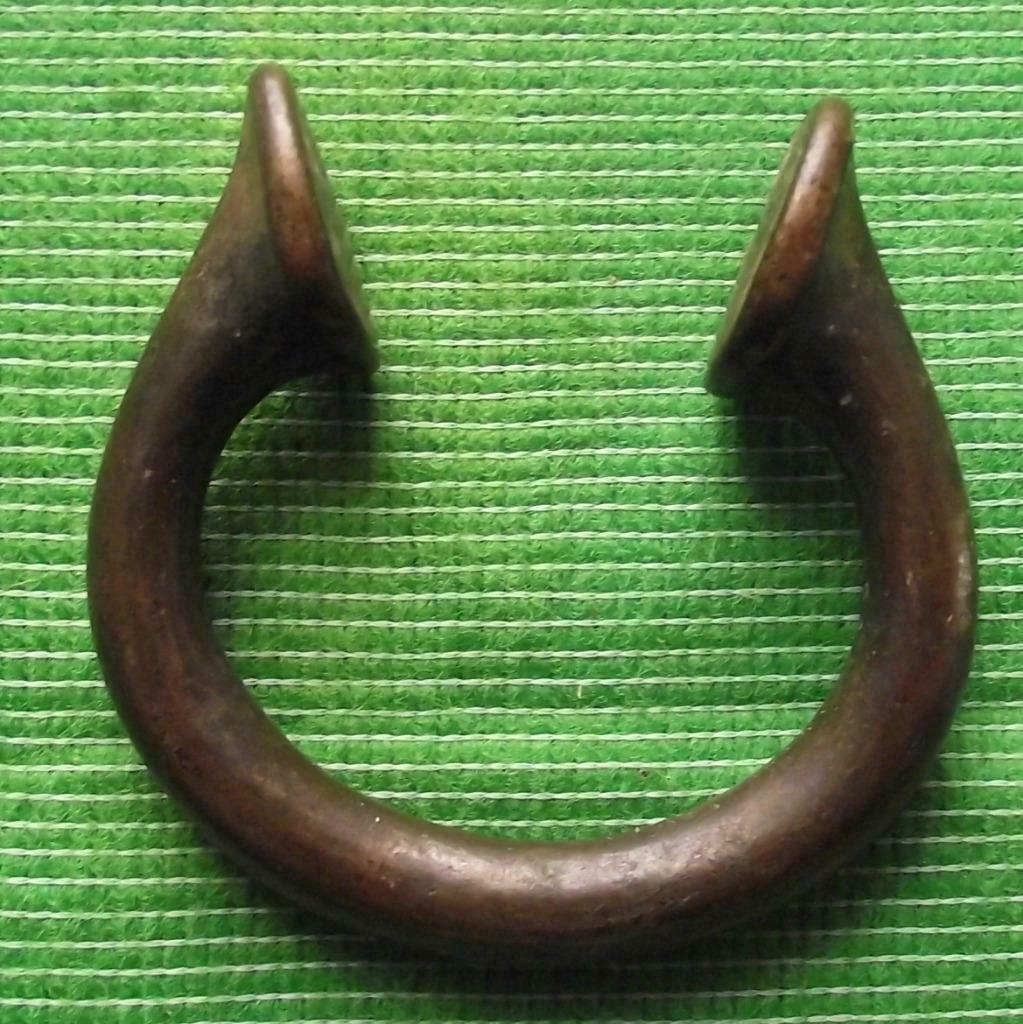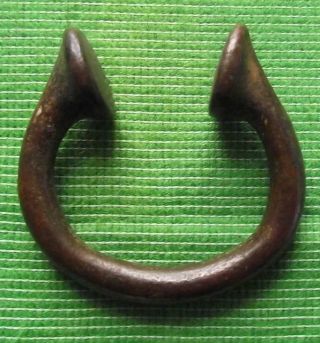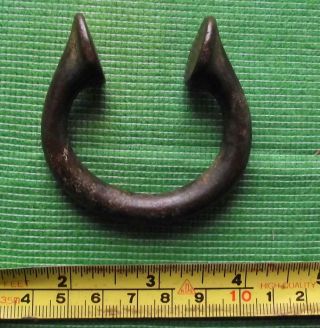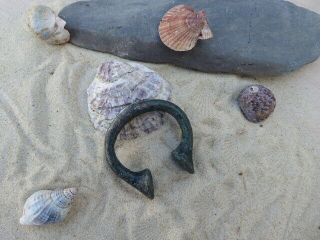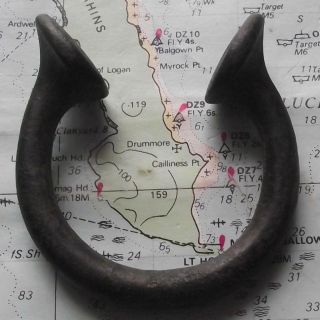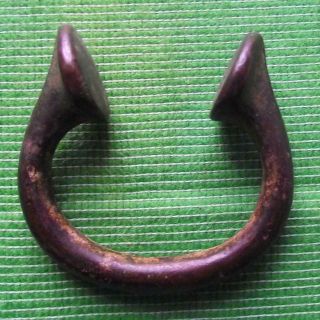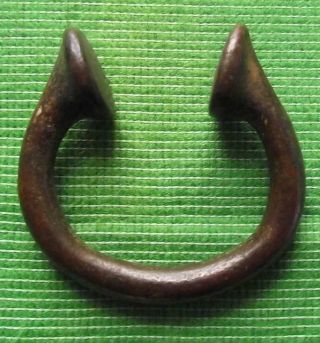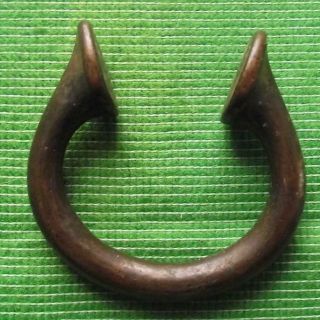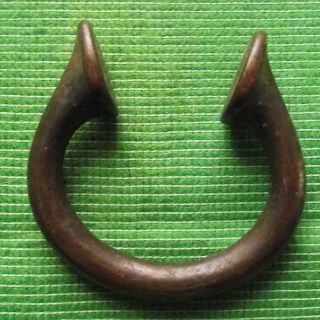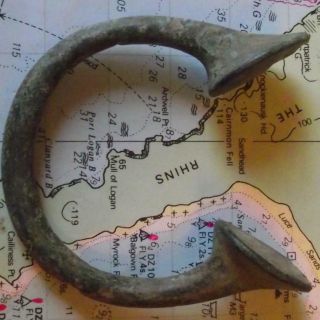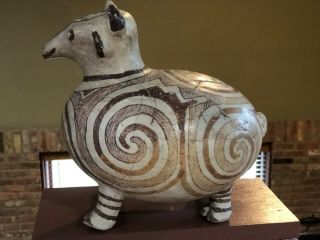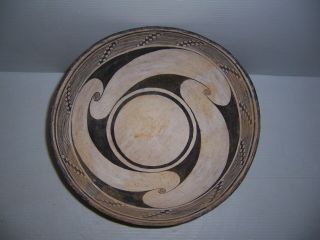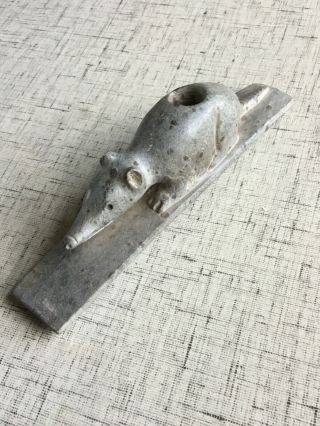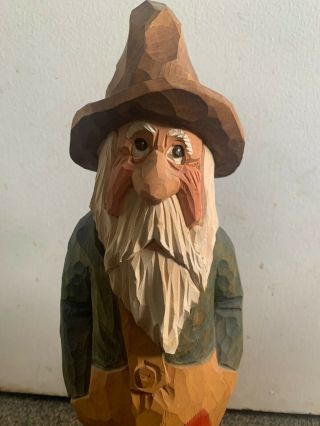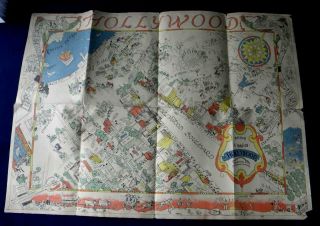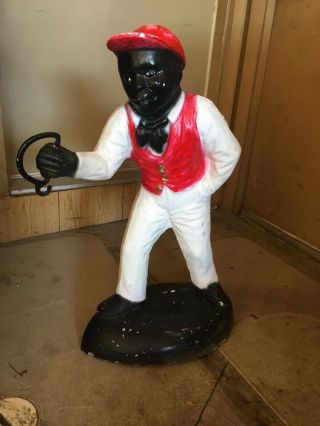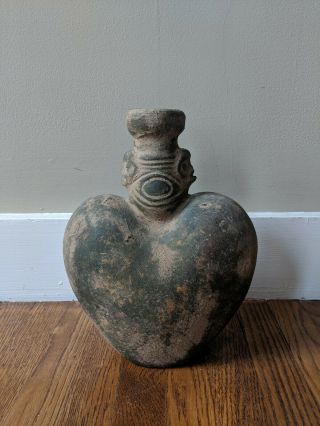Old 18th Century Bronze Manilla Penanular African Slave Trade Bracelet Money J
Item History & Price
| Reference Number: Avaluer:18727290 | Age: 18th Century |
| Type: Rings | Item: Manilla Bracelet Slave Money |
| Material: Bronze |
Old 18th Century Bronze Manilla Penanular African Slave Trade Bracelet Money J Click images to enlarge Description Old 18th Century Bronze Manilla Penanular African Slave Trade Bracelet MoneyThis is an Old 18th Century Bronze Manilla Penanular African Slave Trade Bracelet Money. The size is an shown in the photo with the Scale. It has a stunning patina as seen.
Manillas (which were a traditional African exchange medium) were originally metal bracelets or armlets. Later forms were made of copper, bronze, or brass open rings (penannular or almost ring-like), often horse-shoe shaped with enlarged finial terminations. The term is derived from the Spanish for bracelet or manella or the Portuguese for hand-ring (Rees 2000). The origin is from the Latin manus (hand) or monilia, or monile the plural for necklace. The universal name for manillas, which are an ancient form of money or barter coinage, is Okpoho. Manillas originated at Calabar and the word 'okpoko' is the Calabar, Efik, Annang, and Ibibio term for money or brass.During the 1470s Portuguese explorers became aware that, all along the west coast of Africa, copper bracelets and leg-bands were a means of exchange. Copper, regarded as the ‘red gold’ of Africa, was mined and then traded across the Sahara by merchants from Italy and Arabia. This ‘red gold’ was seen always as the primary metal for exchange and value judgements (Herbert, 1984), whereas gold was regarded by Africans for purposes of adornment and the export trade. For internal purposes one of the oldest, and original general-purpose currencies, was the copper or bronze manilla, and were known at Calabar in 1505. By 1859 manillas were reported on the Benin River and again seen in Calabar in 1688. (Einzig, 1949). These early Portuguese traders bought tusks , peppers, and slaves by exchanging currency 'bracelets' acceptable to the Africans (Rees, 2000). Eventually manillas became known as slave trade money after they were used by Europeans to acquire slaves. The slave trade in question was that to England and the Americas prior to 1807. Furthermore, Dutch traders “…bought slaves against payment in rough grey copper armlets which had to be very well made, otherwise the natives rejected them by the hundred.” (Meek, 1937). A slave cost about 12 to 15 brass manillas in the 1490s but correspondingly less if they were of copper (Rees, 2000). With inflation a female slave aged 16 in Benin cost between about 50 manillas in 1522. Indeed, smaller pattern Popo Manillas, which were too small to wear as bracelets, were manufactured in Birmingham solely for the slave trade.The earliest use of manillas was in West Africa. As a means of exchange they originated in Calabar. Calabar was the chief city of the ancient southeast Nigerian coastal kingdom of that name. It was here in 1505 that a slave could be bought for 8-10 manillas, and an elephant’s tooth for one copper manila (Einzig, 1949; Talbot, 1926). Manillas were noted by voyagers and traders on the Benin River in 1589 and at Calabar in 1688. African names for manillas varied according to local customs. The Mkporo was probably a British or Dutch origin manila but a Popo was French. The British Consul to Fernando Po (1856) delineated 5 different manilla types used in Nigeria (Einzig, 1949). There was the Antony Manilla which was valued in interior markets; the ‘bottle necked’ Congo Singolo which was valued only in the market at Opungo; the Onadoo was best for trade in the Kingdom of Calabar, and also in Igbo country between New Kalahari and Bonny; worth half the value of an Antony the Finniman Fawfinna was acceptable in Qua market as well as Julu Town; finally other patterns of manilla represent types evolving at their point of manufacture in Birmingham, England. The Ibos of Nigeria and the Guineans still used manillas as currency in the nineteenth century (Talbot, 1926) (Einzig, 1949).By the early sixteenth century the Portuguese were actively engaged in the slave trade. Evidence shows that manilas were carried by bearers into the African interior. Eventually the Portuguese lost their monopoly to the English, French and Dutch – all of whom possessed labour intensive plantations in the Caribbean and eventually the Americas. Utilitarian brass manilas were transported from Europe, mainly England, to West Africa. Manillas were then exchanged for slaves who were then transported to the Americas and the West Indies. The final leg of the triangle saw American cotton shipped to Europe. Manillas eventually became the main currency underpinning the slave trade, but the price “… of a slave expressed in manillas varied considerably according to time, place, and the specific type of manila offered.” (Rees, 2000). In 1788 a Thomas Williams (1737-1802), the so-called ‘Copper King’ from Angelsey, and his partners “…declared that the slave trade in particular had led them to invest heavily in the copper industry.” (Herbert, 1984; Harris, 2003).The Nigerian manillas in the African manilla trade have been described as “…an open bracelet in the form of a horseshoe with lozenge shaped ends, measuring about 2 ¼ inches across and weighing about 3 ounces.” (Herbert, 1984). They are the latest and the smallest pattern manilla and worth, prior to their withdrawal in 1949, three English pence or 20-25 centimes. Bristol, in the early 18th century, was a centre for the copper industry. An important manufacturer was R & W. King who were eventually absorbed by the later United Africa Company. After this period the most significant city manufacturing brass wares in Europe was Birmingham. Most patterns of manilla were made in Birmingham, including the middle period Nkobukob-Onoudu and the lighter in weight late pattern types. Pieces exported from Birmingham in 1836 appear to be of the smaller type – compared to the heavier Portuguese type of the 16th century. A later type was the Okpoho which is the Efik word for brass. Many Okpoho manillas were salvaged from the wreck of the slave ship Douro off the Isles of Scilly in 1843 (Receiver of Wrecks, 2003).In the 1690s a series of fortuitous developments in the brass industry of Britain improved production. This eventually gave British manufacturers the edge in the brass trade in Africa. This led to the development of the crescent-shaped and flared ended brass piece known as the Birmingham manilla. These were well made and weighed about 90 grams though a larger pattern was about 300 grams. The trade in copper became enmeshed in the slave trade when Birmingham developed into a centre for finished brass wares. In 1767 a factory in Warrington was manufacturing manillas, in 1767 a Warmly company stocked listed its Guinea manillas, and the Cheadle Brass Wire Company opened its Manilla House and Assay Office in 1790 (Herbert, 1984).Bracelets and manillas were being replaced by western currencies by the end of the 19th century. Bristol established an important role in African commerce after 1807 in the palm oil trade. Manillas of various types were traded for oil instead of slaves.Please note I am based in Scotland I will be happy to combine postage for multiple purchases , please wait for me to send you a combined postage invoice.Conditions of Sale !!!BID NOW - TO AVOID DISAPPOINTMENT!!!PLEASE LOOK AT THE SCANS CAREFULLY TO ASCERTAIN CONDITION ///PAYPAL/ -STERLING UK PERSONAL OR BUSINESS CHEQUES / UK POSTAL ORDERS / BANKERS DRAFTS OR INTERNATIONAL MONEY ORDERS IN GREAT BRITISH POUNDS/ DOLLARS/EUROS / /// N.B. :- I NOW ALSO ACCEPT USA PERSONAL CHEQUES )/// PLEASE NOTE BUYER TO PAY POSTAGE AND PACKAGING AT COST :- ALWAYS REASONABLE AND FAIR ///PLEASE read the following VERY carefully BEFORE placing your bidThe following text is taken directly from eBay's "Confirm Bid" page.'Your bid is a contract - Place a bid only if you're serious about buying the item If you are the winning bidder, you will enter into a legally binding contract to purchase the item from the seller. You should contact the seller to resolve any questions before bidding :- All items are described as accurately as possible, but I am only human & can make mistakes. If theres a problem let me know and I will do my up most to resolve it. I will send you shipping and payment information when the auction ends. If you don't receive this, PLEASE contact me, e-mails sometimes go astray! You will have 7 days after the auction ends in which to send payment of the full amount before I re-list the item or offer it to another bidder.If I do not hear from you Non Paying Bidder action WILL follow, simply because this is the only way I am able to recover my eBay listing fees. I will make every effort to post your item with a few days of receiving payment, but please allow time for the item to arrive. Please feel free to mail me after a reasonable time if you have still not received your item, and I will do my best to help. Please leave feedback once your item has arrived and you are happy with it Please make sure that you ask any questions and request photographs before bidding. I am happy to spend as much time as necessary in providing any information requested. Images sell!
Get Supersized Images & Free Image HostingCreate your brand with Auctiva's
Customizable Templates.
Attention Sellers - Get Templates
Image Hosting, Scheduling at Auctiva.com.
Track Page Views With
Auctiva's FREE Counter



